Life and work: Part 2
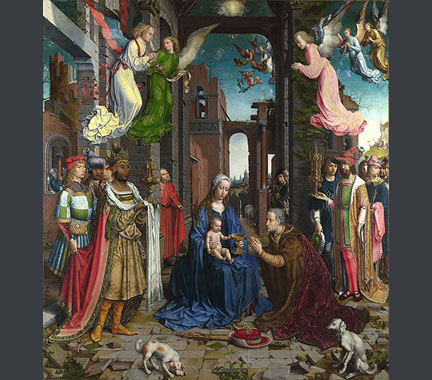
Throughout his time in Philip’s employment, c.1508–24, Gossart worked for other patrons. Many of them were close friends or relations of Philip and they must have had his permission to employ Gossart. The ‘Adoration of the Kings’ (NG2790: fig.6) was almost certainly commissioned by Philip’s close associate Daniel van Boechout for the Chapel of Our Lady in the abbey church of St Adrian at Geraardsbergen. The double-winged polyptych of the ‘Descent from the Cross’ was painted between 1518 and 1520 for the church of the Premonstratensian Abbey of Middelburg and was commissioned by Philip’s nephew Maximilian of Burgundy, who became abbot in 1518. Admired by Dürer in December 1520,13 the altarpiece was destroyed by lightning in 1568. The Carondelet diptych (Louvre), signed and dated 1517, was made for Jean Carondelet: Philip owned a bust of Carondelet, who was clearly a dear friend14 and who had a house in Brussels.15 Gossart also worked for members of the Habsburg dynasty: Charles V and Margaret of Austria, who employed Philip and were descendants of his niece Mary of Burgundy. In 1523, when Gossart worked for 15 days at Mechlin to restore pictures in Margaret’s collection, he stayed with the sculptor Conrad Meit, who was in Margaret’s service. The ‘Saint Luke drawing the Virgin’ (Prague: fig.7), perhaps of about 1515, was painted for the chapel of the Painters’s Guild in the church of St Rombout in Mechlin. It was probably commissioned by the officials of the Guild, who must somehow have obtained Philip’s permission to employ his painter.
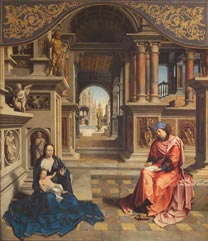
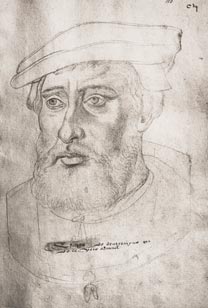
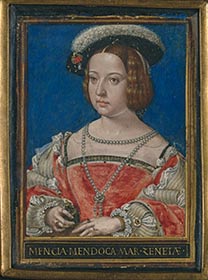
After Philip’s death, Gossart appears to have found employment in the household of Philip’s great-nephew Adolf of Burgundy (1489–1540), Lord of Veere (fig.8). In 1525–6 and 1528, he worked for the exiled Christian II of Denmark; and he continued to paint portraits for Margaret of Austria. During the last year of his life, Gossart had a pension from Mencía de Mendoza, Countess of Nassau, who was then residing at Breda (fig.9). He received a payment of 20 florins at Breda on 27 March 1532. Mencía and her husband, Henry III of Nassau, then granted him a pension of 100 florins of 20 ‘sous’ payable in three instalments every year. He received the first instalment in May 1532; a second in September 1532; but died before receiving the third. On 13 October, his widow received 20 florins from Mencía’s ‘Mayordomo mayor’. In Gossart’s last years, he and his family probably lived in Veere; it was in the Orphans’s Chamber of Veere that his and his widow’s estates were settled.16
Jean’s brother Nicaise or Nicasius also used the names Mabuse and Gossart, and also went to Zeeland. There in 1529–31 he was making models of the old port of Middelburg and the new harbour that was being planned. He advised on works there and died in 1536 or 1537.17 Three drawings bear early inscriptions giving his name;18 on two is written: ‘Nicasius gossart van Mabuse’;19 on the third is written: ‘Nicasius van Mabuyse’.20
Jean’s wife was Margaretha ’s Molders, or ’s Moelders or de Moelder. They had two daughters and a son, Pieter, who was still under age in 1536 and who was to become a painter. Nothing is known about Margaretha’s parents. It is sometimes claimed, for no real reason, that she was a member of the same family as the Antwerp carver Jan de Molder.21 Another possibility is that she was from Brussels and that she may have been related to Johanna de Molder or ’s Molders, the mother of Bernard van Orley; or to Catherine, daughter of Joos de Molder and widow in 1491 of Jan van Conincxloo called de Schermer, one of another large family of prominent artists of Brussels;22 or to Geertruyd Molders, who married the Brussels painter Rombout van Ingelghem.23 Painters named Aerde de Moldere and Frederik Smolders were working in Leuven in 1528 and 1548 respectively.24
Several paintings and drawings bear inscriptions incorporating one or more of Jean’s names: Jennin Gossart, or Jean de Maubeuge, translated into Latin as Ioannes Malbodius or Mabusius and into Dutch as Jan van Mabuse. Some of these inscriptions are genuine but it is not always easy to distinguish the real from the false signatures. Those that are beautifully lettered, like those on the ‘Adoration of the Kings’ (NG2790: figs.10, 11), are usually considered reliable. Those that are less elegantly written may be completely spurious; or they may be copies after damaged inscriptions or after signatures once on original frames and lost when those frames were removed.25 Two engravings and two woodcuts are inscribed: IMS, taken to be an abbreviation for I[oannes] M[albodius] S[culpsit] – or perhaps, because S[culpsit] may be anachronistic, S[imulavit].26 Even during the sixteenth century, there was some confusion over attributions. In 1588, for example, a ‘Virgin and Child’, then in the Augustinian Convent at Leuven, was valued as the work of ‘Jannyn Mabuyse’; it is now in the Prado, attributed to van Orley.27 Van Mander in 1604 attributed to van Orley the Prague ‘Saint Luke drawing the Virgin’, then in Mechlin; it is signed by Gossart (fig.7).28
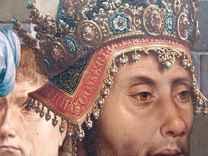
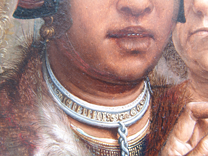
Jean or Jennin (little John) Gossart came from Maubeuge and was evidently proud of the fact, as he signed his ‘Adoration of the Kings’ IENNI/ GOSSART: DEMABV… and was later to sign ‘Ioannes Malbodius’. Because Maubeuge is in Hainault, he has been identified as the Jennyn van Henegouwe, Jennin of Hainault, who became a master of the Antwerp Guild of Saint Luke in 1503 (when Gossart would have been about 26) and who took apprentices in Antwerp in 1505 and 1507.29 The profession of this Jennyn is nowhere stated in the Antwerp records but his identification with the young Gossart gains some support from the inscriptions: ANWER and IENNI on a drawing of ‘Augustus and the Sibyl’ (Berlin: fig.12).30 ANWER is claimed to stand for Antwerp[en] and IENNI for Jenni[n Gossart]. The drawing, however, may include views in Brussels rather than Antwerp. If Gossart was indeed the ‘Jennyn van Henegouwe’ who worked in Antwerp, he would have left his two apprentices stranded there when in October 1508 he set out for Rome.31
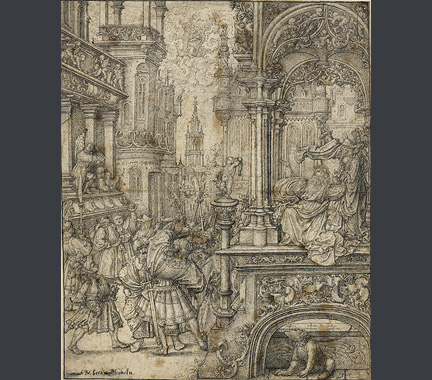
14. Sterk, p. 234: ‘Een gebacken hoeft nae de figuer van Carondelet ende is gesonden mijnen heere van Parlermen tot zijnder instantie’ (inventory of Philip’s property in the castle of Duurstede, February 1529).
15. It was in the Coudenberg area and was uninhabited in 1526: Cuvelier 1912, p. 254.
16. Gossart 1903, pp. 143–5.
17. Gossart 1903, pp. 57, 143–5.
18. Alsteens in Ainsworth et al. 2010, pp. 99, 102 note 76.
19. The ‘Holy Family with Saint Catherine and another Female Saint’ (Albertina 17552), also inscribed, on the garments of the second saint: [G]OSA[RT]M[?], attributed by Alsteens to Jean Gossart (Alsteens in Ainsworth et al. 2010, pp. 320–2); and the ‘Abraham and Melchizedek’ (Albertina 7837), attributed to an Antwerp artist of about 1520 (Benesch 1928, pp. 6–7 [34], Tafel 10; van den Brink 2005, p. 187).
20. The ‘Judgement of Paris’ (Edinburgh D 652), attributed by Alsteens to the Circle of Jean Gossart (Alsteens in Ainsworth et al. 2010, p. 406).
21. Duverger 1968, p. 18; Ryszard Szmydki, ‘Jan de Molder peintre et sculpteur d’Anvers au XVIe siècle’, ‘JKMSKA’, 1986, pp. 31–58. His assertion that Margaretha was Jan de Molder’s sister is without any foundation in fact.
22. O. Le Maire, ‘Renseignements nouveaux sur Bernard van Orley et sa famille’ in ‘Bernard van Orley 1488–1541’, published by the Société royale d’archéologie de Bruxelles, 1943, pp. 167–89 (p. 174).
23. René Goffin, ‘Généalogies Nivelloises’, première partie (A.-J.) (Société archéologique et folklorique de Nivelles et du Brabant wallon, Annales, Vol. XV), Charleroi 1951, p. 128.
24. Van Even 1869, pp. 297, 312.
25. See the selection of signatures reproduced by Ainworth in Ainsworth et al. 2010, p. 10.
26. See Orenstein in Ainsworth et al. 2010, pp. 104–12, 407–26.
27. Van Even 1869, pp. 301–6; Friedländer, vol. VIII, no. 129.
28. Ainsworth in Ainsworth et al. 2010, pp. 150–4.
29. Rombouts and Van Lerius 1864–76, I, pp. 58, 63, 66.
30. Alsteens in Ainsworth et al. 2010, pp. 262–4.
31. The first, ‘Hennen Mertens’, was in the middle of his term; the other, ‘Machiel int Swaenken’, had just started his apprenticeship. According to Duverger 1968, Hennen Mertens was the ‘Jan Mertens, Janssone, scildere’ who became a master of the Guild in 1509–10 (Rombouts and Van Lerius 1864–76, I, p. 71). If that is the case, then Jennyn van Henegouwe must have been a painter and may very well have been Gossart. Duverger (1968, p. 19) is inclined to equate the second apprentice with the ‘Machiel van Dijke’ who started an apprenticeship in 1508 with ‘meester Frederyck’ [Wydenere, printer] (Rombouts and Van Lerius 1864–76, I, p. 70) but who did not reappear in the records of the Antwerp Guild of Saint Luke.
